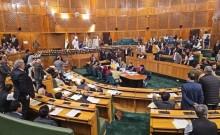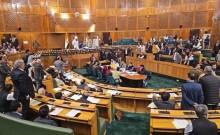
The battle has been well fought since the Election Commission sounded the bugle on April 11. After a marathon run, tons of predictions and analysis made during the exit polls have finally come true. After an arduous race, the masses favourite, Narendra Modi, the son of a tea seller and a formidable politician, is back at HQ.
What Played Into Modi's Hands & Not For Rahul Gandhi?
To begin with, Narendra Modi or NaMo as he is popularly known had been a clear front runner. The media narrative was skewed right from the beginning, an aspect team Modi had not failed to capitalise on even in 2014, a phenomenon never seen before in the history of Indian elections. The name of the winning party is synonymous with Modi and here's a man who knew exactly how to connect with voters across platforms effortlessly. Also, the tagline 'Modi hai to mumkin hai' (If Modi is there everything is possible) made the party indistinguishable from the larger-than-life personality at the top.
Whilst the BJP dripped glitz, on the other hand, if jokes in the political circles are to be believed, Congress is a 'poor party with wealthy leaders!' It's not a surprise thereby that the opposition has been wounded several times by NaMo's huge resource edge across India. Plus, the 8.4 crore 1st-time voters, the millennials were more shaped by Modi's 'how's the josh' (how's the spirit) pitch than anything else.
Modi's name started weighing in on the psyche of Indians after February's Indian Air Force strikes in Balakot, Pakistan. A number of analysts evaluated Modi's net approval rating across India that had stood low at the beginning of 2019 but quickly skyrocketed by February 27, a day after the strikes, seen as the latest example of his decisive leadership. Even after the Kargil War, the BJP had done well in some of the largest states of the country. Vajpayee's popularity had increased tremendously. The same happened with Modi. The math was simple – a snowballing focus on India-Pak tensions deflected attention from the condemnation the party was facing on unemployment, agrarian crisis and the alleged Rafale scam.
As soon as Modi made national security his foremost agenda, it quickly translated into seats. Also, the 2018 Budget, the last one for the incumbent government helped improve the way voters perceived Modi's reign. There was something for everyone which led to heightened optimism and economic cheerfulness. Deal-making with smaller parties - the Shiv Sena, JD(U), Shiromani Akali Dal and AIADMK, spread across India played a big role in determining who became India's next PM. Conversely, regional parties played smart by siding with the bigger player rather than in joining hands in a shaky regional grouping and feel threatened.
On the contrary, Congressmen were optimistic that the party was on the road to recovery and could play a critical role in forming a UPA 3 but jumping from 44 to 140 to get a majority even in a coalition was a very difficult feat to achieve. Rahul Gandhi tried very hard to defeat Modi by trying to entice the public, but that backfired. Instead, what he should have done is try and win over a united opposition, rival leaders who might have scored a majority in Parliament. Now, here's a mistake he'll probably not fail to recall for decades. His strategy simply didn't work.
I remember reading headlines about a mahagathbandhan (grand alliance) conundrum just a few days back, between smaller state parties who were bridging gaps in order to build a Pan-India opposition and defeat the Modi-Shah machine. Unquestionably, the tactic rebounded. Despite victories in the three important Hindi heartland states, the Congress failed to build on the momentum.
![Mayawati and Akhilesh Yadav [Representational Image] Mayawati and Akhilesh Yadav](https://data1.ibtimes.co.in/en/full/706622/mayawati-akhilesh-yadav.jpg?h=450&l=50&t=40)
Modi was quick to learn, knowing full well elections were due in a few months, he quickly overcame weaknesses and announced sops to farmers, upper castes and medium, small and micro-enterprise units. The grand old Nehru-Gandhi party got Priyanka Gandhi who looks eerily similar to the duo's all-conquering grandmother Indira Gandhi, into active politics but the stratagem failed to shake the box office.
Here's something possibly funny and interesting at the same time. Even if Modi did lose, he would have still won 50 million more votes than US presidential candidates Donald Trump and Hillary Clinton garnered together in 2016. He would also, surprisingly, represent one of the world's three largest Muslim populations.
What Next For Narendra Damodardas Modi?
Modi's 2nd term will likely be more divisive. Under Modi, India has begun to catch up to China and will possibly march ahead soon. India has also become a hotbed for overseas investments and the bar had been set rather high if Modi won a 2nd term. Now that he has, global funds and strategists are eager to back Modi and the markets valued at more than a $1 trillion.
On top of all this, the BJP had pledged to spend $1.44 trillion on infrastructure to boost India's economy, in a bid to match its main rival's populist promises. Global funds' confidence is based on the fact that Modi commits himself to economic reforms and boost India's growth momentum. Investors are harping on the fact that, the winner, in this case, Modi, must use his powers to create jobs, fix India's financial drainage, improve infrastructure and bring about financial sector reform.
Also, one more ingredient that worked in favour of the Modi government was the numerous economic reforms, namely a unified tax reform, bankruptcy rules and finally demonetization that though had an initial setback for the masses will have positive ripples for several years to come, something I am sure even the opposition would not have undone had they won. The country faces deep structural problems that need to be addressed. More immediately, there is a well-entrenched financial cyclical slowdown underway, which demands urgent attention.
[Dr Somdutta Singh, (PhD) Economics, former vice-chairperson NASSCOM Product Council, core committee member, WEP — NITI Aayog, is an Indian entrepreneur and angel investor. The views and opinions expressed in this article are those of the author's and do not reflect that of International Business Times, India]








